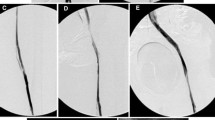Abstract
Purpose
This study was designed to evaluate the technical success and the early clinical outcome of patients undergoing percutaneous aspiration thrombectomy (PAT) for the treatment of arterial thromboembolism following percutaneous infrainguinal transluminal angioplasty (PTA).
Methods
In this single-center study, during a period of 7 years retrospectively, 47 patients (22 male, 47 %) with a mean age of 73 (range 53–96) years were identified in whom PAT was performed for the treatment of thromboembolic complications of infrainguinal PTA. Primary technical success was defined as residual stenosis of <50 % in diameter after sole PAT, whereas secondary technical success was defined as residual stenosis of <50 % in diameter after PAT and additional PTA and/or stenting. Clinical outcome parameters (e.g., need for further intervention, minor/major amputation) were evaluated for the 30-day postinterventional period.
Results
Primary technical success was achieved in 64 % of patients (30/47); secondary technical success was obtained in 96 % of patients (45/47). Clinical outcome data were available in 38 patients. In 87 % of patients (33/38), there was no need for further intervention within the 30-day postinterventional period. In three patients, minor amputations were conducted due to preexisting ulcerations (Rutherford Category 5 respectively).
Conclusions
PAT enables endovascular treatment of iatrogenic thromboembolic complications after PTA with good technical and early clinical results and minimal morbidity.

Similar content being viewed by others
References
Davies B, Braithwaite BD, Birch PA et al (1997) Acute leg ischaemia in Gloucestershire. Br J Surg 84:504–508
Norgren L, Hiatt WR, Dormandy JA et al (2007) Inter-society consensus for the management of peripheral arterial disease (TASC II). Eur J Vasc Endovasc Surg 33(Suppl 1):S1–S75
Spiliopoulos S, Katsanos K, Fragkos G, Karnabatidis D, Siablis D (2012) Treatment of infrainguinal thromboembolic complications during peripheral endovascular procedures with AngioJet rheolytic thrombectomy, intraoperative thrombolysis, and selective stenting. J Vasc Surg 56:1308–1316
Karnabatidis D, Katsanos K, Kagadis GC et al (2006) Distal embolism during percutaneous revascularization of infra-aortic arterial occlusive disease: an underestimated phenomenon. J Endovasc Ther 13:269–280
Tsetis D, Uberoi R (2008) Quality improvement guidelines for endovascular treatment of iliac artery occlusive disease. Cardiovasc Intervent Radiol 31:238–245
Gardiner GA Jr, Meyerovitz MF, Stokes KR et al (1986) Complications of transluminal angioplasty. Radiology 159:201–208
Sniderman KW, Bodner L, Saddekni S, Srur M, Sos TA (1984) Percutaneous embolectomy by transcatheter aspiration. Work in progress. Radiology 150:357–361
Fogarty TJ, Cranley JJ, Krause RJ, Strasser ES, Hafner CD (1963) A method for extraction of arterial emboli and thrombi. Surg Gynecol Obstet 116:241–244
Cleveland TJ, Cumberland DC, Gaines PA (1994) Percutaneous aspiration thromboembolectomy to manage the embolic complications of angioplasty and as an adjunct to thrombolysis. Clin Radiol 49:549–552
Vorwerk D (2006) Mechanical thrombectomy is an alternative way to go: the European experience commentary on: quality improvement guidelines for percutaneous management of acute limb ischemia. Cardiovasc Intervent Radiol 29:7–10
Wagner HJ, Starck EE (1992) Acute embolic occlusions of the infrainguinal arteries: percutaneous aspiration embolectomy in 102 patients. Radiology 182:403–407
Starck EE, McDermott JC, Crummy AB et al (1985) Percutaneous aspiration thromboembolectomy. Radiology 156:61–66
Starck EE, Wagner HJ (1991) Rotation aspiration thromboembolectomy. Dtsch Med Wochenschr 116:1–6
Rastan A, Sixt S, Schwarzwalder U et al (2007) Initial experience with directed laser atherectomy using the CLiRpath photoablation atherectomy system and bias sheath in superficial femoral artery lesions. J Endovasc Ther 14:365–373
Wagner HJ, Starck EE, Reuter P (1994) Long-term results of percutaneous aspiration embolectomy. Cardiovasc Intervent Radiol 17:241–246
Conflict of interest
Dr. Stephan Schleder, Matthias Diekmann, Prof. Dr. Christoph Manke, and PD Dr. Peter Heiss have no conflict of interest to report.
Author information
Authors and Affiliations
Corresponding author
Rights and permissions
About this article
Cite this article
Schleder, S., Diekmann, M., Manke, C. et al. Percutaneous Aspiration Thrombectomy for the Treatment of Arterial Thromboembolic Occlusions Following Percutaneous Transluminal Angioplasty. Cardiovasc Intervent Radiol 38, 60–64 (2015). https://doi.org/10.1007/s00270-014-0857-6
Received:
Accepted:
Published:
Issue Date:
DOI: https://doi.org/10.1007/s00270-014-0857-6




